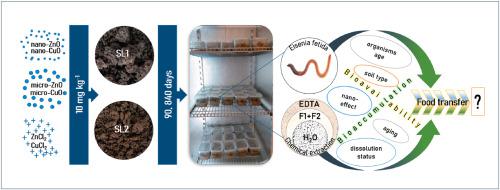Chemosphere ( IF 8.1 ) Pub Date : 2020-11-23 , DOI: 10.1016/j.chemosphere.2020.128982 Izabela Jośko , Magdalena Kusiak , Patryk Oleszczuk

|
The bioavailability and bioaccumulation of metal-based engineered nanoparticles (ENPs) in soils need to be evaluated in environmentally relevant scenarios. The aim of this study was an analysis of potentially available metal–component ENPs (nano-ZnO and nano-CuO) in soils. Earthworms (Eisenia fetida) were used to examine the bioaccumulation potential of ENPs. Micro-particles (micro-ZnO and micro-CuO) and metal salts (ZnCl2 and CuCl2) were used to evaluate the nano-effect and the activity of dissolved ions, respectively. Zn- and Cu-compounds were added to sandy loam and silt loam at a concentration of 10 mg kg-1. The bioavailable fractions of metals were extracted from soil using H2O, MgCl2 with CH3COONa or EDTA. EDTA was the most effective extractant of Zn and Cu (10.06–11.65 mg Zn kg-1 and 2.69–3.52 mg Cu kg-1), whereas the H2O-extractable metal concentration was at the lowest level (1.98–2.12 mg Zn kg-1 and 0.54–0.82 Cu mg kg-1). The bioavailable metal concentrations were significantly higher in silt loam than sandy loam soil, which was related to the higher pH value of silt. There were no significant differences between the Zn content in the earthworms incubated in the two soils, which may confirm the auto-regulation of the Zn content by earthworms. However, the bioaccumulation of Cu was strongly correlated with the extractable Cu concentrations. The juvenile earthworms accumulated Cu and Zn more than adults. Based on our results, aging neutralized the differences between the ionic and particulate effects of metal–compounds.
中文翻译:

CuO和ZnO纳米颗粒对费氏艾美耳球菌的慢性影响与老化土壤中生物利用度的关系
需要在与环境相关的情况下评估土壤中金属基工程化纳米颗粒(ENP)的生物利用度和生物蓄积性。这项研究的目的是分析土壤中潜在可用的金属成分ENP(纳米ZnO和纳米CuO)。f(Eisenia fetida)用于检查ENPs的生物蓄积潜力。使用微粒(微ZnO和微CuO)和金属盐(ZnCl 2和CuCl 2)分别评估了纳米效应和溶解离子的活性。将锌和铜化合物以10 mg kg -1的浓度添加到沙壤土和粉砂壤土中。使用H 2 O,MgCl 2从土壤中提取金属的生物利用级分与CH 3 COONa或EDTA。EDTA是锌和铜的最有效萃取剂(10.06-11.65 mg Zn kg -1和2.69-3.52 mg Cu kg -1),而H 2 O可萃取的金属浓度最低(1.98-2.12 mg Zn) kg -1和0.54-0.82 Cu mg kg -1)。粉质壤土中生物可利用金属的浓度显着高于沙质壤土,这与粉土的pH值较高有关。在两种土壤中培养的earth中的锌含量之间没有显着差异,这可以证实confirm对锌含量的自动调节。但是,铜的生物积累与可提取的铜浓度密切相关。少年earth的铜和锌的积累量超过成虫。根据我们的结果,时效消除了金属化合物的离子效应和颗粒效应之间的差异。











































 京公网安备 11010802027423号
京公网安备 11010802027423号